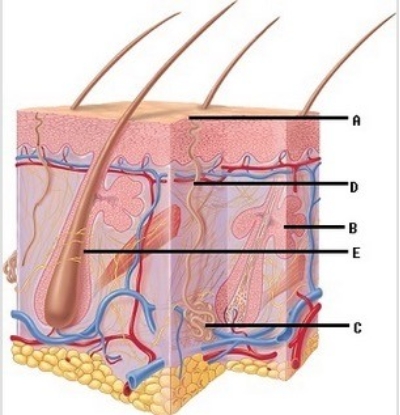A) color of the skin.
B) amount of pain.
C) rule of nines.
D) cause of the burn.
E) ABCDE rule.
G) A) and B)
Correct Answer

verified
Correct Answer
verified
Multiple Choice
The stratum corneum beneath the free edge of the nail is the ________.
A) nail root
B) nail body
C) nail fold
D) eponychium
E) hyponychium
G) A) and C)
Correct Answer

verified
Correct Answer
verified
Multiple Choice
 -The diagram illustrates accessory structures of the skin. What does "D" represent?
-The diagram illustrates accessory structures of the skin. What does "D" represent?
A) Sebaceous gland
B) Eccrine sweat gland
C) Duct of eccrine sweat gland
D) Sweat pore
E) Hair follicle
G) A) and B)
Correct Answer

verified
Correct Answer
verified
Multiple Choice
The dermis contains receptors that detect which of the following sensations? (Check all that apply.)
A) Changes in pressure
B) pH differences
C) Pain
D) Touch
E) Variations in temperature
G) C) and D)
Correct Answer

verified
Correct Answer
verified
Multiple Choice
If you accidentally cut your arm and see adipose tissue, which layer(s) was/were cut?
A) Stratum corneum
B) Stratum basale
C) Dermis
D) Subcutaneous layer
E) All of the choices are correct.
G) D) and E)
Correct Answer

verified
Correct Answer
verified
Multiple Choice
Melanin
A) is transferred to other cells by osmosis.
B) is increased with exposure to infrared light.
C) is absent in individuals with albinism.
D) is a pigment produced by cells in the stratum corneum.
E) makes the skin lighter.
G) B) and C)
Correct Answer

verified
Correct Answer
verified
Multiple Choice
The epidermal layer found only in thick skin is ________.
A) stratum basale
B) stratum spinosum
C) stratum granulosum
D) stratum lucidum
E) stratum corneum
G) D) and E)
Correct Answer

verified
Correct Answer
verified
Multiple Choice
Thin skin has only four epithelial strata. It lacks which of the following?
A) Stratum spinosum
B) Stratum granulosum
C) Stratum lucidum
D) Stratum corneum
E) Stratum basale
G) All of the above
Correct Answer

verified
Correct Answer
verified
Multiple Choice
Describe the movement of melanin in the skin.
A) Melanin is transferred from melanocytes to keratinocytes.
B) Melanocytes carry melanin with them as they migrate toward the skin surface.
C) Melanin is transferred from keratinocytes to melanocytes.
D) Melanin is transferred from melanocytes to Merkel cells.
F) B) and C)
Correct Answer

verified
Correct Answer
verified
Multiple Choice
Which region of the nail contains the stratum basale layer?
A) The matrix
B) The free edge
C) The hyponychium
D) The cuticle
F) All of the above
Correct Answer

verified
Correct Answer
verified
Multiple Choice
Which of the following statements concerning hair is true?
A) In males, the hairs of the beard are vellus hairs.
B) Both vellus and terminal hairs are pigmented.
C) The majority of hair on the chest is vellus hair.
D) At puberty, much of the vellus hair is replaced with terminal hair.
E) Hair in the axillary region is vellus hair after puberty.
G) C) and E)
Correct Answer

verified
Correct Answer
verified
Multiple Choice
Friction ridges of the hands and feet are produced by projections into the epidermis called ________.
A) dermal striae
B) cleavage lines
C) reticular lines
D) melanocytes
E) dermal papillae
G) B) and E)
Correct Answer

verified
Correct Answer
verified
Multiple Choice
By reducing body temperature during hot weather, skin helps to maintain
A) homeostasis.
B) body structure.
C) blood volume.
D) brain activity.
E) blood pH.
G) A) and D)
Correct Answer

verified
Correct Answer
verified
Multiple Choice
 -The diagram illustrates accessory structures of the skin. What does "A" represent?
-The diagram illustrates accessory structures of the skin. What does "A" represent?
A) Sebaceous gland
B) Eccrine sweat gland
C) Duct of eccrine sweat gland
D) Sweat pore
E) Hair follicle
G) A) and E)
Correct Answer

verified
Correct Answer
verified
Multiple Choice
Light-skinned individuals have
A) more melanocytes than individuals with darker skins.
B) fewer melanocytes than individuals with darker skins.
C) approximately the same number of melanocytes as individuals with darker skins.
D) more melanin in their skin.
E) a different kind of melanin in their skin.
G) A) and E)
Correct Answer

verified
Correct Answer
verified
Multiple Choice
The central axis of the hair is the ________.
A) shaft
B) cuticle
C) hair bulb
D) medulla
E) root
G) C) and D)
Correct Answer

verified
Correct Answer
verified
Multiple Choice
All of the following are complication of a major burn except
A) fever.
B) electrolyte imbalance.
C) hypermetabolic state.
D) weight loss.
E) decreased protein demand.
G) B) and E)
Correct Answer

verified
Correct Answer
verified
Multiple Choice
At birth the hairs of the scalp, eyelids, and eyebrows are replaced by coarser pigmented hairs called ________ hairs.
A) terminal
B) primary
C) lanugo
D) vellus
E) pubic
G) A) and E)
Correct Answer

verified
Correct Answer
verified
Multiple Choice
Which of the following represents the correct order of the layers of the epidermis from the deepest to the most superficial?
A) Stratum basale, stratum granulosum, stratum lucidum, stratum spinosum, and stratum corneum
B) Stratum basale, stratum spinosum, stratum granulosum, stratum lucidum, and stratum corneum
C) Stratum lucidum, stratum granulosum, stratum corneum, stratum basale, and stratum spinosum
D) Stratum spinosum, stratum basale, stratum lucidum, stratum corneum, and stratum granulosum
E) Stratum corneum, stratum lucidum, stratum granulosum, stratum spinosum, stratum basale
G) A) and D)
Correct Answer

verified
Correct Answer
verified
Multiple Choice
The dermal layer closest to the epidermis is the ________.
A) stratum basale
B) reticular layer
C) papillary layer
D) stratum lucidum
E) subcutaneous tissue
G) B) and C)
Correct Answer

verified
Correct Answer
verified
Showing 81 - 100 of 175
Related Exams